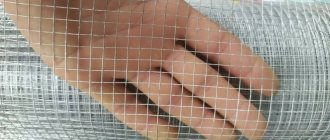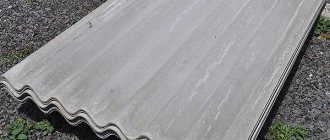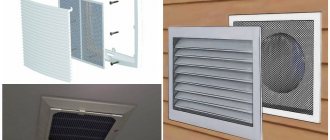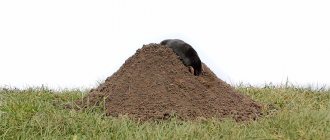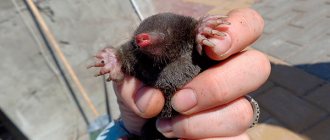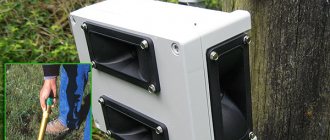Moles are destroying your property, but you are not ready to exterminate them using inhumane traps? The only way out is a mole net. The device is very simple, does not require special installation skills, and lasts for many years. But in order for the “barrier” to protect, you need to know some features and we will understand them.
Total protection against moles – how does it work?
The anti-mole net is a solid fabric made of durable polymer or metal with small cells of different diameters. The smaller the “clearance”, the more effectively your area will be protected from annoying shrews and other pests. The principle of operation of the design is that the mesh is laid at a shallow depth (approximately 5-10 cm) and completely blocks the animal, which seeks to dig a passage onto the surface of the lawn and throw out the soil.
This is interesting ! Moles on the site - benefit or harm?
When faced with a barrier, the mole is forced to turn to the side and begin to dig through the tunnel again. If the mesh is dug in throughout the entire area, the shrew will have to go deep into the ground, looking for a way out, or simply leave the area. At first glance, it is not difficult to protect your site, but there are nuances that must be taken into account when laying a grid.
Harm from moles
These cute animals cause a lot of damage in the area. They are capable of chewing the roots of trees, plants, cables, and water pipes. When mounds of fresh soil appear, action must be taken.
Mole: friend or foe.
Mesh price: approximate estimate for purchase and installation
Approximate prices for a roll of mole netting were indicated above. Let's now figure out how much the total cost of installing such a grid on the site will cost. We will carry out calculations based on the price of the Italian Syntoflex - this mesh is quite economical and reliable.
If you fence a plot of 10 acres (25x40 m) around the perimeter, then the main costs will be:
- Roll of mesh - 13,000 rubles;
- Digging a trench - 14,000 rubles (the price indicated is for a full shift of work, although usually a soil cutter makes a trench of this length in 4-5 hours);
- The payment for workers who will cut the mesh, install and fill the trench is 10,000 rubles.
In total, it turns out 37,000 rubles for all the work. In this case, 70 meters of mesh 1 m high will still be left on hand. The specific price of installing the mesh will be 300 rubles per meter of the border of the site, the price of the mesh alone is 65 rubles per meter of the protected border.
You can save money if you lay the mesh and fill the trench yourself, and also negotiate with the soil cutter on an hourly payment or payment per meter of the trench. In addition, these works can be combined with the installation of foundation posts for a mesh or slate fence, which will save money on both works in total.
Review
“We have been fighting moles for so long, it has already begun to seem that this fight will be endless. We catch them, but they still climb. We poison, and then new ones come, nothing works to scare them away. In the end, they decided to fence themselves off. In the spring, we dug trenches along three fences (we dug them by hand, a tractor cannot enter the site), bought a mesh to protect against moles, G-9, installed it, and buried it. The overlap was made in such a way that the mesh rests directly on the fence and the mole cannot get through on the ground above it. This was the first year when moles did not harm the site. That's all, the long-term saga is over. I remember what happened before, and I understand that we spent more money on all these repellers and traps than on the net. And there were so many nerves, so many damaged flowers!”
Tatyana, Minsk
If the mole net is laid horizontally, then the cost of the work will depend on the cost of lifting the soil and laying it on top of the net. The mesh itself costs 65 rubles per square meter of protected surface. If you lay it on top of the lawn without burying it, then this, in general, will be the unit cost of all materials per square meter.
Protective mesh
Mole net.
The mesh is made in the form of a continuous fabric, which is based on durable materials. Thanks to the cellular structure, oxygen access is not limited. However, it blocks the path of pests. The smallest cell sizes are more efficient. This mesh can also protect against other pests.
The canvas is immersed in the ground to a depth of 10–15 cm to block the animal’s exit from the hole. The animal encounters an obstacle and digs new passages. Protection along the entire perimeter of the site will not allow pests to invade
Methods for eliminating moles other than mesh
What to do if underground pests have multiplied, but the owners are not ready to spend tens of thousands of rubles - buy an EcoSniper LS-997R mole repeller. This is a device for all-season use, operating on the principle of delivering an ultrasonic signal. Thanks to their acute hearing and sense of smell, shrews perfectly hear the entire spectrum of sounds and, at the slightest discomfort, quickly leave their burrows. EcoSniper LS-997R delivers ultrasound in a range that humans cannot hear, but is perfectly detected by moles, rats, mice and other pests. In terms of power output, the signal is similar to the roar of an airplane turbine. Animals cannot stand such noise and therefore try to go to a quieter place as quickly as possible.
Unlike a mole net, the repeller does not need to be buried around the entire perimeter; it is buried in one point of the garden and turned on. All. The device will perform further work itself. In order to completely expel pests, the device is turned on at a certain period of time. Then once a season a preventive inclusion is made. Mole repeller EcoSniper LS-997R does not kill animals, does not cause them physical harm, and is safe for humans and pets. Depending on the power, the device covers up to 45 meters, so the radiation of the wave will affect not only the beds, but also the cellar, basement, garage - all those places where rodents love to live.
By purchasing EcoSniper LS-997R, the owner receives a guaranteed result without tedious excavation work. And to choose a repeller, call our operators. An experienced manager will help you choose a device that is suitable for individual conditions of use, terrain and other features of the site. And remember, moles do not hibernate in winter, so now is the time to take care of preserving the harvest.
Grid selection
It is appropriate to use various layout methods:
- vertical;
- horizontal;
- universal.
Before laying, they lift the soil and dig a trench. For these purposes, you can hire equipment.
Some recommendations to take note:
It is better to choose a metal canvas . The metal mesh does not have to be changed quickly, because it is much more durable.
They prefer plastic construction. This material is resistant to frost and moisture. Plastic will not rot or rust.
diameter should be up to 25 mm. Not only moles, but also mice or rats will not get through such holes.
Do-it-yourself mole traps
DIY mole repeller
There are many types of mole traps that you can make with your own hands from scrap materials. They are made using:
- metal or plastic pipe
- plastic bottles
Mole trap
Mole trap No. 1
It is a plastic pipe with a diameter of 9 to 12 mm; these are the passages the mole digs. There are doors at both ends that only open inward.
The device is installed in the wormholes. The animal, crawling through the tunnel, pushes the door, gets inside and cannot get out. Several animals can fall into such a trap from different sides. There are descriptions of gardeners catching 3-4 moles at once in this way. You can make such a trap yourself.
For this you need:
- a piece of plastic or iron pipe;
- a small piece of sheet metal to make doors;
- wire;
- drill.
Mole traps
Drill 2 holes on both sides of the pipe. Cut out the doors, making allowances for bends to attach to the wire. Insert one end of the wire into the hole, hang the door, secure it, insert the wire into the other hole, securing the ends from the outside. Check if it opens well inwards. Attach a small stopper to the bottom or side to prevent the doors from opening outward.
Additional Information! A mole cannot fast for more than 6 hours. If a shrew gets caught in the trap along with a mole, it will most likely be eaten.
Trap #2
Anyone can make a mole trap from a plastic bottle. To make this device you will need 3 plastic bottles of the same diameter and capacity. The bottom and neck of one are cut off to make a long cylinder, the other two are cut in half. For work you will need halves with tops. The necks must be cut so that they move apart, like the petals of a flower. Insert both bottles with their necks inward into the plastic cylinder prepared in advance. Anyone can make such a mole trap in 10 minutes. It is installed in underground mole tunnels.
The animal, crawling inside, bends the petals, but can no longer get out. To lure a mole, you can put several earthworms inside the structure, but you need to remember that if the goal is not to kill the animal, but only to get rid of it, you should check the traps every 6 hours. To do this, they are not covered with earth on top, but covered tightly with cloth, boxes, boards, so that sunlight does not penetrate. The mole sees poorly, but he can distinguish bright light. Without food, the animal will quickly die; you need to take it 1 km from the site and release it.
Mole Repeller
Installation nuances
There are various options for installing a mesh under the lawn. The most common is the layout around the entire perimeter. This will protect you from moles from the outside.
Correct installation of the mesh.
The best option for plots of no more than 30 acres. If the dacha is enclosed by a fence on a strip foundation, then the mesh is dug in from the unprotected side. The depth should be about 0.8 m to block the entrance and exit.
If there are pests underground, they must first be caught. Otherwise there will be no effect.
Horizontal grid
A feature of horizontal laying is that the soil is raised by 10–15 cm. Next, a protective sheet is placed and sprinkled with earth. It is important that the sheets are tightly connected. Otherwise, the animal will move the net away. This method is appropriate when arranging a lawn.
Vertical installation
For areas intended for beds and bushes, it is better to choose a different method. The disadvantage of this layout in such areas is the possibility of digging passages under the canvas.
The vertical method is done in a limited area. They are deepened by 15 - 20 cm, there should be 30 cm of mesh at the top. This is a good option for high beds, but inconvenient for flower beds.
Options for using anti-mole nets
There are two main options for laying polypropylene anti-mole mesh protection:
- vertical - protects the area from penetration of moles from the outside;
- horizontal - prevents rodents from coming to the surface.
There is also an island option, as a special case of horizontal installation. This method is used to protect a separate area - flower beds, beds, etc.
Vertical method
Polypropylene mesh is laid vertically around the perimeter of the site. Laying depth is up to 80 cm. It makes no sense to make protection deeper, since moles live only in this soil horizon.
Advantages and disadvantages
The advantages include:
- long-term operation;
- the possibility of humane control of animals;
- eliminating the threat from rodents and shrews.
Flaws:
- large volume of earthworks. In the case of a lurking mole, this will be a useless process. Over time, the number of animals will increase, they will cause harm;[/webnavoz_plus]
- In some cases, it is impossible to fence off the entire area. The mesh is designed for lawns;
- When digging up the garden, the protective cloth is lifted and removed. Then it needs to be laid down again. This costs a lot of money, effort and time;
- the likelihood of damage to the root system, which will spoil the ripening process.
Some gardeners note that canvases are not particularly effective. After 6 months, users discovered holes.
A mole cannot chew through plastic. But rats and mice can do it. Accordingly, it is better to purchase a dense, high-quality mesh. However, this option is more expensive.
All types of mole nets and which one is better to choose
A mesh with a mesh size of no more than 25x25 mm should be used against moles, preferably 15x15 mm. For example, a standard chain-link will not create any obstacles for animals - a medium-sized mole can easily squeeze through a mesh 55x55 mm wide.
Many stores today sell special anti-mole nets and gratings; they are easy to buy not only in Moscow and St. Petersburg, but also in small towns. If you still cannot find mesh on sale, then you can use universal construction meshes for the same purposes; they usually turn out to be cheaper.
Lawn plastic nets made of polypropylene are optimal for protecting against moles. They are very durable, are not damaged when exposed to environmental factors (rain, frost, soil microorganisms, etc.), and if the mesh is of high quality, then moles will not be able to tear it.
Metal mesh is much less preferable. In just a few years, they can become so rusty that they can no longer perform their protective function.
If the mesh is dug in vertically, then its height above the ground surface should be at least 20-30 cm, although summer residents usually prefer to make a full-fledged fence more than 1 meter high.
The following options are available for sale from plastic nets specially produced for protection against moles:
- Lawn 1 (article G-8), mesh size 8x6 mm, roll size - 1x10 m, 2x30 m. Price of a 2x30 m roll - about 8-10 thousand rubles, production - Premium, Russia;
- Lawn 1/1 (article G-9), mesh size 9x9 mm, roll dimensions are the same, a 1x10 m roll costs just over 1000 rubles, and 2x30 m costs about 6000 rubles, production - Premium, Russia;
- Syntoflex, mesh size 12x14 mm, roll size - 2x100 m, roll price - approximately 13-15 thousand rubles, production - Tenax, Italy.
As practice shows, Italian mesh turns out to be not only the most economical, but also the most durable and reliable, although it looks thinner. The video below shows its benefits.
Interesting video: which anti-mole mesh is better
However, thick mesh also protects, so the effect will still be there, it’s just that such protection will be somewhat less reliable.
Premium nets with a mesh size of 35x35 mm should no longer be used - a young mole can squeeze through such a mesh.
Review:
“Our Lawn-1 mole net lies under the entire lawn. It lies very well, no infection has ever damaged the grass. Sometimes molehills appear in the garden; one or two moles always live there, but they cannot get out onto the lawn. And this despite the fact that we did not bury the mesh, but simply laid it on the ground and compacted it. In my opinion, it cost 15 thousand rubles, and they also bought the skating rink there. This is our best defense so far.”
Irina, St. Petersburg
If the mole has already made its way
If a mole already lives on the site, it must first be expelled, or destroyed, as you wish. Using the links to articles on the portal, you can get acquainted with materials that will help fight pests.
Plants are a safe way to protect your area from moles and other rodents.
Mole traps allow you to catch the pest quickly and easily.
The greenhouse requires protection from moles; they are comfortable there at any time.
Proven methods of controlling moles on the site. Fast and efficient.
What is the danger from moles on the site
Small mammals are real cuties, but only in pictures. In nature, these are carnivorous predators up to 17 cm long. Moles live only in the thickness of the soil, weigh up to 70 g and the female bears up to two offspring per year. The animal's body is covered with soft fur, suitable for making clothing, so moles are also commercially hunted.
The main problem for gardeners is the rodent's front paws, which are crowned with large and hard claws. By raking with its paws, the animal can dig up to 20 m of tunnels per day. The rest of the body is weaker. While digging a molehill, the individual screws its muzzle into the smallest holes and instantly widens the hole with its paws. Moles are blind by nature, but have a keen sense of hearing and touch, so they often avoid poisonous baits and traps.
Why use mole nets and other methods of exterminating animals:
- Voracious individuals eat any insects, without understanding whether they are useful for the garden or not. And if there are no mole crickets, the moles will eat the earthworms that loosen the soil in the garden. Cannibals by nature, animals eat their offspring and can attack a weaker relative.
- On its way, the mammal tears apart everything it gets its hands on. The roots of plants, trees, cables, and water pipes suffer.
- Mice and rats instantly appear in old molehills. One family of such pests can destroy the entire crop on the site.
All rodents are carriers of diseases dangerous to humans. Fleas settle on the skin of animals, and there may be worm eggs in the excrement and saliva. Work on the destruction of animals is carried out with gloves. You cannot pick up moles; they are quite aggressive animals that can bite or scratch.

